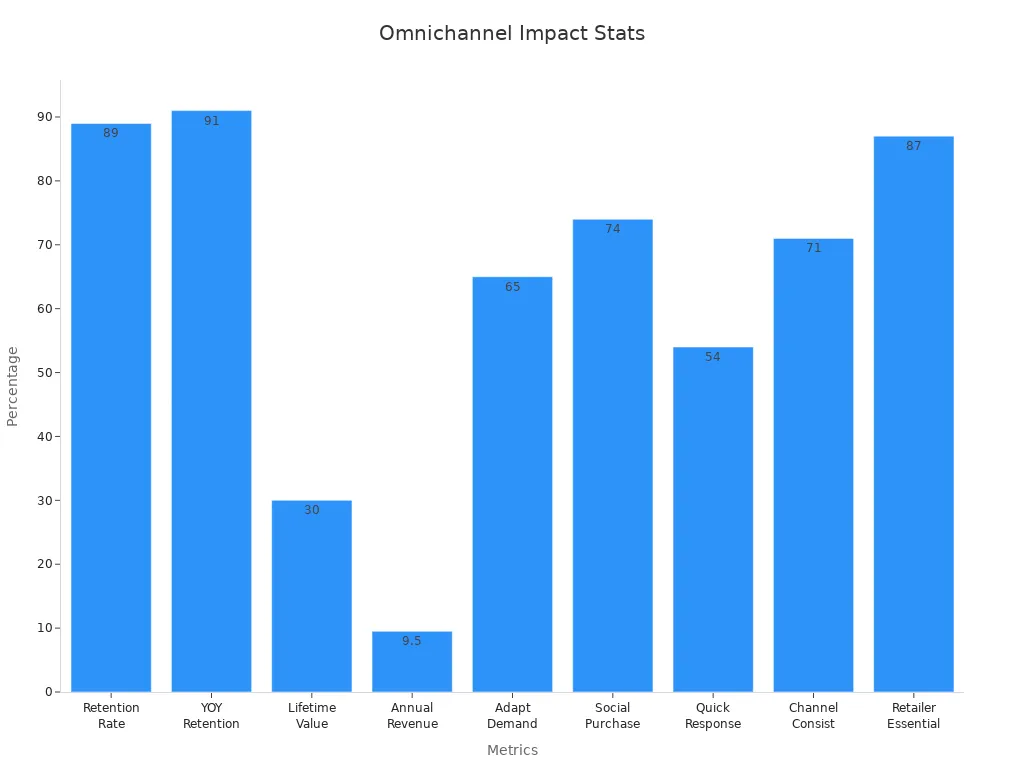Omnichannel Marketing: From Buzzword to Bottom-Line Impact

Omnichannel Marketing transforms business outcomes by unifying customer touchpoints with a data-driven focus. Companies embracing this approach see a 250%–287% rise in purchase rates and a 9.5% annual revenue increase. Customers expect consistency, with 71% seeking seamless experiences across channels. The table below highlights key metrics:
Metric Description | Value |
|---|---|
Increase in purchase rate on omnichannel platforms | 250%-287% |
Annual revenue increase for omnichannel companies | 9.5% |
Customers expecting consistency across channels | 71% |

Key Takeaways
Omnichannel marketing unifies all customer touchpoints to deliver consistent, personalized experiences that boost engagement and loyalty.
Customers expect fast, easy, and seamless service across channels, making omnichannel strategies essential for meeting these rising demands.
Using unified customer data and AI-powered tools enables businesses to personalize interactions, increase sales, and improve customer lifetime value.
Successful omnichannel marketing requires breaking down data silos, fostering cross-team collaboration, and continuously measuring and optimizing performance.
Companies that implement omnichannel strategies see clear business benefits like higher revenue, better customer retention, and improved operational efficiency.
Omnichannel Marketing Defined
What Is Omnichannel Marketing?
Omnichannel Marketing creates a unified customer experience across all touchpoints. Companies use this approach to connect with customers on websites, mobile apps, social media, email, and in-store visits. Each channel works together, so customers see the same message and brand values everywhere. This strategy relies on data to understand customer behavior and deliver personalized experiences.
Businesses measure success by tracking customer engagement, loyalty, and retention. They also look at acquisition rates and how well they personalize each interaction. For example, a company might use testing rates as a stand-in for prescription rates to see if a campaign works. Brands like Starbucks, Nike, Sephora, and Amazon have shown that this approach leads to higher engagement, repeat purchases, and better customer understanding. Companies also gain efficiency by using data analytics to improve operations.
Key benefits of omnichannel marketing include:
Consistent and integrated customer experiences
Higher customer engagement and loyalty
Increased repeat purchases and customer acquisition
Better insights into customer behavior
Improved operational efficiency
Technology and data management play a big role in making these results possible. Companies use customer data platforms and analytics tools to solve challenges like system integration and personalization.
Omnichannel vs. Multichannel Approaches
Omnichannel and multichannel strategies both use multiple channels to reach customers, but they work in different ways. Omnichannel marketing puts the customer at the center. All channels connect and share data, so customers get a seamless and personalized experience. For example, a shopper can start browsing online and finish buying in-store without any confusion.
Multichannel approaches focus on the channels themselves. Each channel operates on its own, often leading to mixed messages and inconsistent experiences. Customers might see different prices or promotions depending on where they interact. This can cause confusion and lower loyalty.
Omnichannel strategies help businesses build stronger relationships with customers. They lead to more frequent purchases, larger order values, and higher satisfaction. Multichannel strategies may work for startups or companies that want to reach a broad audience quickly, but they often lack the integration needed for long-term loyalty.
Why Omnichannel Marketing Drives Business Results
Meeting Evolving Customer Expectations
Customers today expect more from brands than ever before. They want fast, easy, and personalized service at every touchpoint. Companies that fail to meet these expectations risk losing business and damaging their reputation. The following points highlight how customer behavior and trends shape these expectations:
53% of bad customer experiences lead to reduced spending, showing the financial impact of unmet expectations.
Improving customer experience ratings from low to moderate increases repurchase likelihood by 68% and recommendation likelihood by 97%.
Consumers prioritize trust, which strongly connects to repeat purchases and recommendations.
Communication issues often cause poor experiences, making clear and consistent engagement essential.
Nearly 60% of the world population uses social media, spending an average of 2.5 hours daily, which raises expectations for quick responses.
64% of customers tried new engagement channels like live chat during the pandemic, and 75% plan to keep using them.
87% of consumers maintain or increase digital channel usage after the pandemic, highlighting the need for omnichannel engagement.
Customers demand fast and easy resolutions, consistent service, personalized experiences, 24/7 availability, and free or quick shipping.
Social media allows customers to share feedback publicly, increasing pressure on brands to respond quickly and effectively.
80% of customers expect chat representatives to help with support, sales, and more, reflecting rising expectations for comprehensive service.
Customers want personalized, humanized interactions using their data.
Agility and AI-powered tools are critical for meeting fast, seamless support demands.
Proactive communication and openness to feedback help brands manage and exceed evolving customer expectations.
Brands that listen and adapt to these trends build stronger relationships and drive long-term loyalty.
Seamless Brand Experiences Across Channels
A seamless brand experience means customers receive the same message, service, and value no matter where they interact with a company. This consistency builds trust and encourages repeat business. Companies that deliver seamless experiences see measurable gains in customer satisfaction and revenue. The table below shows the impact:
Metric Description | Statistic / Result | Source |
|---|---|---|
89% | Aberdeen Group | |
Lifetime value of omnichannel shoppers | 30% higher than single-channel shoppers | |
Revenue growth with strong CX strategy | 1.5x higher than companies without | Forrester |
Increase in customer satisfaction due to AI in CX | 25% increase | Gartner |
The sports brand Slazenger used an AI-powered omnichannel customer journey orchestrator to send personalized messages across Web Push, SMS, and Email. This approach led to a 49X return on investment within two months and a 700% increase in customer acquisition. These results show how seamless brand experiences across channels can drive both customer satisfaction and business growth.
Personalization Powered by Unified Data
Personalization stands at the heart of successful omnichannel strategies. Companies that use unified customer data can tailor every interaction to individual needs and preferences. This approach leads to higher engagement, more conversions, and greater loyalty. The table below highlights key benchmarks:
Metric / Benchmark | Description / Impact on Business Results |
|---|---|
Marketing teams achieve significantly increased efficiency and growth. | |
Over 20 Recommendation Strategies | Automated product recommendations improve relevance and save manual effort. |
Auto-Optimization Features | Enhance personalization effectiveness without constant manual adjustments. |
Increased Customer Engagement | Personalized, seamless on-site experiences boost engagement levels. |
Higher Conversion Rates | Tailored offers and content lead to more conversions. |
Improved Customer Loyalty and Retention | Relevant, timely experiences reduce churn and increase lifetime value. |
Reduced Bounce Rates | Personalized search experiences keep customers engaged longer. |
Increased Average Order Values | Personalization drives customers to spend more per transaction. |
Boosted Customer Lifetime Value | A/B testing and personalization optimize long-term customer value. |
Unified Customer Data Platform (CDP) | Consolidates data from multiple touchpoints enabling 360° profiles. |
Behavioral Analytics and AI Tools | Provide deep insights and automate optimization of personalization. |
Unified customer data is essential for effective personalization. It brings together information from many sources to create a complete customer profile. Shopify’s unified data model, for example, combines data from built-in features and third-party apps to give a 360-degree view of each customer. Molly Allen, senior ecommerce manager at Astrid & Miyu, notes that this unified view helps the company scale quickly and manage international growth. Personalization powered by unified data leads to better shopping experiences and stronger business results.
Omnichannel Marketing in Action

Retail Case Study: Boosting Engagement and Sales
Retail brands have seen remarkable results by connecting online and offline experiences. Companies like Matahari, Chow Sang Sang, Nike, Starbucks, and Sephora have used unified data and technology to personalize customer journeys. These brands improved engagement, increased sales, and made operations more efficient. The table below shows how their strategies led to measurable gains:
Brand | Omnichannel Strategy Highlights | Key Results & Revenue Improvements |
|---|---|---|
Matahari | Unified online/offline data into CDP; personalized email campaigns; app push notifications; automated workflows | 328% increase in email open rates; 356x revenue boost; reduced manual effort in campaign launches |
Chow Sang Sang | AI-powered onsite personalization and email recommendations; dynamic algorithms; crowd-sourced email product recommendations | 23.5% uplift in conversion rates; 59% increase in average session duration |
Nike | Mobile app integration with in-store scanning, discounts, and mobile checkout | 40% increase in in-store footfall; 20% higher repeat customer rate; boost in digital sales |
Starbucks | Mobile rewards app syncing mobile, in-store, and online orders with personalized discounts | 12% revenue increase from app users; over 50% of US transactions via app; increased engagement |
Sephora | AI-powered personalization online and in-store; AR tool; centralized loyalty system | 11% higher conversion rates; 3x more website time spent; improved customer satisfaction |
These results show that a connected approach can drive both engagement and revenue in retail.
Financial Services Case Study: Enhancing Customer Loyalty
Financial services companies have also benefited from unified customer experiences. Firms that connect online and offline channels see up to a 30% increase in customer retention rates. McKinsey research shows that companies with strong omnichannel engagement achieve a 9.5% year-over-year revenue growth, compared to only 3.4% for those with weaker strategies. Customer Lifetime Value (CLV) rises as customers receive personalized communication and consistent service. Loyalty programs and seamless support encourage repeat business. Retaining customers costs less than acquiring new ones, and higher retention leads to long-term profitability. Omnichannel support helps companies provide fast, reliable service, which builds trust and loyalty.
Customer retention drives long-term growth and reduces costs, making it a key focus for financial services.
Measurable Outcomes: Revenue, Retention, and Efficiency
Companies that use connected strategies see improvements in revenue, retention, and efficiency. Automation reduces manual work by up to 95%, cutting costs and errors. Claim denials drop by 20%, and claims processing speeds up by ten times. Net Collection Rates reach 95% to 99%, showing strong financial health. Days in Accounts Receivable fall below 50, which means faster payments. Higher Net Promoter Scores (NPS) lead to a 3.2% increase in upsell revenue and a 4.2 times higher chance of repeat purchases. Top-quartile NPS customers have a 13% higher Customer Lifetime Value. Churn drops by 15%, saving millions for large firms.
Metric / Outcome | Value / Impact | Explanation / Relevance |
|---|---|---|
Reduction in manual effort | 95% reduction | Automation in Revenue Cycle Management (RCM) reduces manual work, cutting costs and errors. |
Claim denials reduction | 20% reduction | Fewer denials improve cash flow and revenue accuracy. |
Claims processing speed | 10x increase | Faster processing accelerates revenue recognition. |
Net Collection Rate (NCR) | 95% - 99% | KPI benchmark indicating strong financial stability. |
Days in Accounts Receivable (A/R) | Under 50 days | KPI benchmark for efficient receivables management. |
Upsell revenue boost | 3.2% increase per 10+ point NPS gain | Direct revenue growth linked to customer satisfaction. |
Repeat purchase likelihood | 4.2 times higher for promoters | Stronger retention and recurring revenue. |
Customer Lifetime Value (CLTV) | 13% higher for top-quartile NPS | Long-term financial benefit of loyal customers. |
Churn reduction | 15% reduction | Significant cost savings in acquisition and retention. |
Annual savings from churn reduction | $7.5 million (example firm) | Quantifies financial impact of improved retention. |
Overcoming Omnichannel Marketing Challenges

Breaking Down Data and Team Silos
Many organizations struggle with data and team silos. These silos slow down decision-making and reduce efficiency. Industry surveys show that breaking down silos and consolidating data platforms remain top challenges for data leaders. Common symptoms include manual data workflows, decision bottlenecks, and cross-functional friction. These issues often lead to higher costs and lower trust in data-driven decisions.
To address these challenges, companies can follow these steps:
Conduct a data inventory. Catalog all data sources and identify data owners.
Develop a centralized data repository. This creates a single source of truth and improves data quality.
Foster a culture of data sharing. Encourage collaboration between departments.
Use modern data integration tools. These tools combine data from different systems and reduce manual work.
Monitor and improve data practices regularly. This ensures ongoing progress and adapts to new needs.
Cloud data platforms offer scalability, security, and remote access. Tools like AI-powered visual data pipeline designers help teams consolidate data faster and with fewer technical barriers.
Avoiding Technology-First Pitfalls
Some companies focus on technology first, hoping new tools alone will solve their problems. Studies show that simply adopting technology does not always improve profits, productivity, or employment. Technology-first approaches often fail to deliver real business value.
Better results come from combining technology with tailored support. Successful strategies include:
Providing training in management, marketing, and finance.
Offering access to peer networks and expert advice.
Using ICT-based market information and extension services.
Adapting solutions to local needs and business goals.
No single approach works everywhere. Companies should tailor their strategies and consider the unique needs of their teams and customers.
Proving and Measuring ROI
Measuring the return on investment (ROI) helps companies understand the impact of their efforts. Several financial metrics provide a clear picture:
ROI percentage: (Net Benefits / Total Costs) x 100. For example, a net benefit of $500,000 on a $200,000 investment gives a 150% ROI.
Payback period: Time needed to recover the initial investment. If annual net benefits are $100,000 and costs are $200,000, the payback period is two years.
Net Present Value (NPV): Calculates the present value of future cash flows, minus costs.
Internal Rate of Return (IRR): Shows the expected annual growth rate of an investment.
Cost-benefit ratio: Compares monetary benefits to costs. A ratio above 1 means benefits exceed costs.
Companies should define clear time horizons and use baseline comparisons to measure improvements.
Implementing Omnichannel Marketing Effectively
Mapping the Customer Journey
Successful Omnichannel Marketing begins with a clear understanding of the customer journey. Teams map each step a customer takes, from initial awareness to post-purchase engagement. This process uncovers pain points and highlights opportunities for improvement.
Modern journey mapping tools make this process accessible to everyone in the organization. These tools offer:
Simple interfaces for team-wide collaboration, regardless of technical skill.
Real-time editing, commenting, and sharing features.
Ready-made templates and frameworks to speed up mapping.
Integration with analytics platforms, CRM systems, and customer feedback tools.
Flexibility to handle journeys of different complexity.
Export and presentation options for stakeholder meetings.
Persona integration to keep the focus on real customer needs.
Teams often use platforms like Miro, UXPressia, and Smaply for visualization and collaboration. For analytics and customer feedback, Hotjar, Contentsquare, and Glassbox provide valuable insights. Sentiment analysis tools such as Clarabridge, InMoment, and Qualtrics help capture the voice of the customer.
Effective journey mapping relies on data. Teams track conversion rates at each funnel stage, customer satisfaction scores, support ticket volumes, and Net Promoter Score (NPS) trends. They also monitor customer lifetime value and operational costs. A/B testing validates changes, while before-and-after comparisons show the impact of improvements.
Offline interactions remain important. Teams collect data from in-store surveys, phone calls, and field teams using mobile apps. QR codes and unique identifiers help bridge online and offline touchpoints. Integration with Customer Data Platforms (CDP) and CRM systems creates a 360-degree view of each customer, combining demographic, behavioral, and transactional data.
Tip: Teams should measure baseline KPIs before making changes. This approach makes it easier to prove the value of journey improvements.
Integrating Data and Technology
Data and technology integration forms the backbone of Omnichannel Marketing. Companies must connect data from every channel to create a unified customer experience. This integration supports real-time personalization and informed decision-making.
Organizations use a range of frameworks and tools to achieve this:
ETL (Extract, Transform, Load) tools such as Apache NiFi, Talend, Informatica PowerCenter, Microsoft SSIS, and IBM DataStage handle complex data transformations and scalable integration.
API integration platforms like Kong and MuleSoft connect different systems, enabling real-time data access and reducing manual errors.
Middleware solutions and standardized data formats ensure smooth data flow between platforms. Consistent naming conventions and data types prevent confusion and errors.
Advanced technologies, including predictive analytics, artificial intelligence, and machine learning, enhance dashboards with anomaly detection and forward-looking insights.
Real-world examples show the power of integration. Logistics companies combine warehousing, shipping, and inventory data for real-time tracking. Healthcare networks unify patient records, lab results, and schedules to improve care coordination. Financial organizations merge customer databases, transaction histories, and market trends to boost satisfaction and drive growth.
Performance metrics guide integration efforts:
Data quality: Teams track accuracy and consistency, watching for errors and missing data.
Integration efficiency: Leaders monitor the time and resources needed for integration.
Business impact: Decision-makers assess how integration improves processes and return on investment.
User satisfaction: End users report on the ease of accessing and using integrated data.
Best practices include adopting ETL processes, standardizing data formats, and maintaining ongoing error monitoring. Version control and regular updates keep integration solutions reliable and scalable.
Fostering Cross-Functional Collaboration
Omnichannel Marketing thrives when teams work together across departments. Cross-functional collaboration ensures that marketing, sales, IT, customer service, and analytics teams align their efforts. This approach breaks down silos and accelerates progress.
Several collaboration models support this strategy. The table below outlines key models and their measurable success indicators:
Collaboration Model | Key Components | Measurable Success Indicators |
|---|---|---|
RACI Matrix for Role Clarity | Defines who is Responsible, Accountable, Consulted, and Informed for each task | Reduced confusion, clear accountability |
Communication Plan & Regular Check-Ins | Scheduled meetings and updates to track progress and align teams | Consistent progress tracking, timely issue resolution |
Collaborative Goals & KPIs | Shared objectives aligned with company KPIs | Achievement of KPIs, aligned team efforts |
Project Lead Appointment | Designated leader to coordinate and make decisions | Project milestones met on time, clear leadership accountability |
Cross-Training | Team members learn about other departments | Improved mutual understanding, smoother collaboration |
Use of Collaborative Tools | Real-time updates and transparent progress tracking via project management software | Increased transparency, timely task completion |
Celebrating Wins Together | Recognition of group achievements | Boosted morale, stronger team bonds |
Case studies highlight the impact of these models. Integrated marketing campaigns involving marketing, sales, creative, and analytics teams have driven higher engagement and conversion rates. Product development teams that include engineering, marketing, UX design, and sales align technical specifications with customer needs, leading to more successful launches. Leadership-driven cultural shifts, such as informal brainstorming and cross-functional projects, improve team cohesion and customer satisfaction.
Note: Clear roles, regular communication, and shared goals help teams overcome challenges and deliver seamless customer experiences.
Continuous Measurement and Optimization
Continuous measurement and optimization form the backbone of high-performing Omnichannel Marketing strategies. Companies that excel in this area use a mix of technology, data, and process discipline to drive ongoing improvements. They do not rely on guesswork. Instead, they use real-time data and advanced analytics to guide every decision.
Teams collect data from every customer touchpoint. They use automated tools to spot exceptions and flag issues as soon as they appear. Predictive analytics help them see trends before they become problems. Data validation ensures that information stays accurate and reliable. Pattern recognition tools highlight changes in customer behavior. Advanced visualization dashboards make complex data easy to understand for everyone on the team.
Tip: Real-time dashboards and automated alerts help teams respond quickly to changes in customer behavior or campaign performance.
Optimization benchmarks give teams a clear target. They set these benchmarks by looking at past performance, comparing results with industry standards, and aligning with business goals. Teams also consider the unique context of their company and set progressive targets that push for steady improvement.
Key techniques and benchmarks include:
Real-time data collection from all channels
Automated exception reporting to catch issues early
Predictive analytics for spotting trends and risks
Data validation to maintain accuracy
Pattern recognition for identifying shifts in customer behavior
Advanced visualization tools for clear reporting
Historical performance analysis to set realistic goals
Industry benchmarking for competitive comparison
Strategic alignment with business objectives
Contextual factors to tailor benchmarks
Progressive targets for continuous growth
Regular performance reviews keep everyone focused. Teams meet to discuss results, identify root causes of problems, and plan improvements. They share knowledge across departments to spread best practices. Recognition systems reward teams that achieve or exceed their targets, which boosts motivation and engagement.
Some companies use machine learning and scenario modeling to take optimization further. These advanced tools allow for real-time adaptation of benchmarks. Teams can adjust their strategies on the fly, making the organization more agile and responsive.
Continuous measurement and optimization ensure that Omnichannel Marketing efforts never stand still. Companies that embrace these practices see better results, higher efficiency, and stronger customer loyalty.
Omnichannel Marketing creates real business impact when companies focus on strategy and customer needs. Leading organizations see results through:
Higher customer lifetime value, showing long-term engagement.
Strong conversion rates across channels, proving sales effectiveness.
Improved retention, which lowers churn and boosts repeat business.
Increased engagement, seen in clicks, opens, and social interactions.
Unified data and AI-driven insights help teams deliver seamless experiences. Companies that align teams and measure results outperform those who treat omnichannel as a trend.
FAQ
What is the main difference between omnichannel and multichannel marketing?
Omnichannel marketing connects all channels for a seamless customer experience. Multichannel marketing uses separate channels that do not share data. Omnichannel puts the customer at the center, while multichannel focuses on the channels themselves.
How does omnichannel marketing improve customer loyalty?
Omnichannel marketing delivers consistent and personalized experiences. Customers feel valued and understood. This approach builds trust and encourages repeat business. Companies see higher retention rates and stronger brand loyalty.
What technology supports successful omnichannel strategies?
Companies use customer data platforms (CDPs), analytics tools, and integration software. These tools connect data from every channel. They help teams personalize messages and track customer behavior in real time.
How can a business measure the ROI of omnichannel marketing?
Businesses track metrics like revenue growth, customer retention, and engagement rates. They compare these numbers before and after implementing omnichannel strategies. Clear benchmarks and regular reviews help prove the value of their efforts.
See Also
How Product Development Choices Drive Real Business Results
Understanding The Main Contrasts Between Omnichannel And Multichannel
Creating A Unified Customer Profile Across Digital And Physical Channels
Transforming Customer Insights Into Effective Business Strategies
Using Data To Optimize SKU Management With Key Performance Metrics

